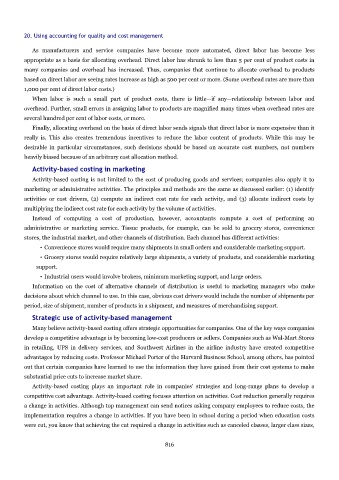Page 815 - Accounting Principles (A Business Perspective)
P. 815
20. Using accounting for quality and cost management
As manufacturers and service companies have become more automated, direct labor has become less
appropriate as a basis for allocating overhead. Direct labor has shrunk to less than 5 per cent of product costs in
many companies and overhead has increased. Thus, companies that continue to allocate overhead to products
based on direct labor are seeing rates increase as high as 500 per cent or more. (Some overhead rates are more than
1,000 per cent of direct labor costs.)
When labor is such a small part of product costs, there is little—if any—relationship between labor and
overhead. Further, small errors in assigning labor to products are magnified many times when overhead rates are
several hundred per cent of labor costs, or more.
Finally, allocating overhead on the basis of direct labor sends signals that direct labor is more expensive than it
really is. This also creates tremendous incentives to reduce the labor content of products. While this may be
desirable in particular circumstances, such decisions should be based on accurate cost numbers, not numbers
heavily biased because of an arbitrary cost allocation method.
Activity-based costing in marketing
Activity-based costing is not limited to the cost of producing goods and services; companies also apply it to
marketing or administrative activities. The principles and methods are the same as discussed earlier: (1) identify
activities or cost drivers, (2) compute an indirect cost rate for each activity, and (3) allocate indirect costs by
multiplying the indirect cost rate for each activity by the volume of activities.
Instead of computing a cost of production, however, accountants compute a cost of performing an
administrative or marketing service. Tissue products, for example, can be sold to grocery stores, convenience
stores, the industrial market, and other channels of distribution. Each channel has different activities:
• Convenience stores would require many shipments in small orders and considerable marketing support.
• Grocery stores would require relatively large shipments, a variety of products, and considerable marketing
support.
• Industrial users would involve brokers, minimum marketing support, and large orders.
Information on the cost of alternative channels of distribution is useful to marketing managers who make
decisions about which channel to use. In this case, obvious cost drivers would include the number of shipments per
period, size of shipment, number of products in a shipment, and measures of merchandising support.
Strategic use of activity-based management
Many believe activity-based costing offers strategic opportunities for companies. One of the key ways companies
develop a competitive advantage is by becoming low-cost producers or sellers. Companies such as Wal-Mart Stores
in retailing, UPS in delivery services, and Southwest Airlines in the airline industry have created competitive
advantages by reducing costs. Professor Michael Porter of the Harvard Business School, among others, has pointed
out that certain companies have learned to use the information they have gained from their cost systems to make
substantial price cuts to increase market share.
Activity-based costing plays an important role in companies' strategies and long-range plans to develop a
competitive cost advantage. Activity-based costing focuses attention on activities. Cost reduction generally requires
a change in activities. Although top management can send notices asking company employees to reduce costs, the
implementation requires a change in activities. If you have been in school during a period when education costs
were cut, you know that achieving the cut required a change in activities such as canceled classes, larger class sizes,
816

